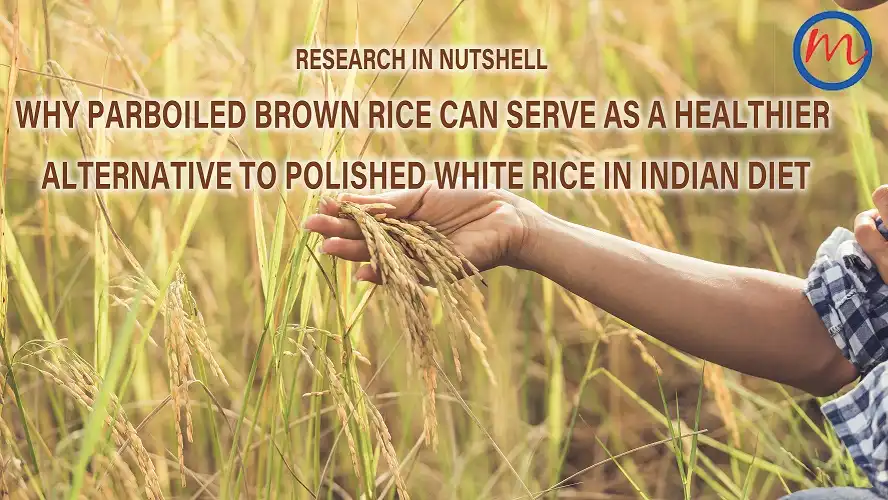In 2017, scientists at the Madras Diabetes Research Foundation undertook a novel research: to put to test varieties of rice in the laboratory. Their aim was to evaluate the effects of different types of rice processing on the nutrition quotient of the commonly consumed grains. Given the rapid rise of chronic diseases in India, their objective was to proffer healthier alternatives to polished white rice in the Indian diet.
They found the parboiled common brown rice to be superior to polished white rice. This was true even for under-milled white rice grains. This study proved for the first time in India how even minimal polishing affects the structural integrity, composition and nutritional quality of rice grains. The following is a sum-up of the study.
FROM FARM TO FORK
The journey of the rice grain from farm to fork is a long one. When paddy comes into the mill and the grain is dehusked before being sent to the market, we get brown rice. When the grains are further passed through abrasive whitening machines, to remove the bran from the kernel, we get white rice—the most commonly consumed rice in India.
There is also rice that is partially boiled in the husk. Called parboiled rice, this type of rice processing is believed to be over 2000 years old. Easy to cook, parboiled rice is also nutritionally superior to regular white rice, as the process drives some of the nutrients, especially B vitamins, back into the grain. Parboiled rice is common in North America and extremely popular in Southern India.
WHITE RICE WOES
Despite the pretty picture white rice makes on the platter, polishing ruins the grain: most of the richest nutrient content—the bran, the aleurone layer and the germ—is removed. Proteins, lipids, vitamins, minerals, fibres are washed away, leaving all the carbohydrates behind. It is well-known that the common Indian white rice grains have a high glycemic index (GI), a scale that ranks foods based on their ability to raise the blood glucose.
GI is an important parameter to determine quality of dietary carbohydrates. With high GI, white rice has been linked to chronic diseases: high blood pressure, belly fat, more of harmful blood fats, high fasting blood glucose, type 2 diabetes and heart disease. It is also well established that brown rice grains lower metabolic syndromes, the risk of diabetes and heart disease.
GAP IN RESEARCH
There is, however, a gap in research: the GI of Indian brown rice varieties are unknown. No data exists on how the GI varies with different degrees of polishing within the same rice variety. This study examined the GI of three types of the common Bapatla Indica rice grains: parboiled brown rice with 0% polish, under-milled rice with 2.3% polish and white rice with 9.7% polish.
The objective has been to evaluate the effect of polishing on the GI of Indian parboiled brown rice. This variety has been chosen as it is one of the most common rice grains consumed in southern India. Earlier studies have shown similar glycemic responses to a single long grain Indica rice variety. However, there are no data on the GI of parboiled brown rice and white rice, and none that compare under-milled grains and rice processed to different degrees of polish.
METHOD FOLLOWED
The Bapatla grains were procured from the National Seeds Corporation, Chennai, India. The glycemic properties of rice vary due to several factors: varieties of grains, processing methods (such as type of parboiling, milling, pre-germination, degree of gelatinisation, physical form as food, degree of chewing, type of starch content. Moreover, each variety of rice may have unique carbohydrate profile and molecular architecture. For this reason, the same variety and batch of grains, grown under identical conditions, were studied.
The grains were cleaned and parboiled by soaking in cold water for seven hours and steaming for 10 minutes. Grains were then dried and dehusked to prepare brown rice. A portion of it was milled in Buhler emery polishers—to a degree of 2.3% and 9.7%—based on the amount of bran or polishing removed. A total of 12 healthy participants, between age 20 and 45, participated for the GI study. In addition, there were 13 overweight individuals for continuous glucose monitoring (CGM).
KEY POINTS TO NOTE
- Parboiled brown rice exhibited a lower glycemic response compared with under-milled rice and white rice. It could serve as a healthier alternative to polished white rice in Indian diet.
- White rice and under-milled rice did not differ in their 24-hour glycemic response and glycemic index, which may reflect the deleterious effect of even minimal polishing on structural integrity, composition, as well as fibre content.
- The lower GI of brown rice was probably due to its higher fibre content from the intact bran and germ. Although under-milled rice had considerable amounts of fibre, it had a disturbed or scratched bran layer. Hence it had a GI similar to white rice.
- This suggests that the glycemic as well as physical properties of brown rice depend also upon structural characteristics (such as intactness of bran and its fat content, and not on the fibre content alone. Even the removal of small amounts of bran can alter the rate of hydration, cooking, textural features of cooked rice and may adversely affect glycemic response.
- Similar to earlier studies, the results show that parboiling appears to have no effect on the GI. Parboiled white rice is similar in GI to other raw (non-parboiled varieties) white rice varieties.
- Food structure plays a vital role in determining the glycemic properties of food. Brown rice, under-milled rice and white rice had similar endosperm features, except for the differences in the degree of milling. However, the distinct differences in the cooking characteristics may be attributed to the intactness, the level of the bran content and the rate of hydration and gelatinisation.
- Bran thickness (in the case of brown rice) and extent of bran removal in milled rice contributes to the cooking characteristics of rice—as the bran layer in brown rice contains fat and wax, which forms a barrier for water absorption during cooking.
- The increased cooking time could have led to rupture of intact bran and increased gelatinisation, resulting in the brown rice showing medium rather than low GI, as would have been expected for a whole grain. Conversely, under-milled rice had a high GI, in spite of lesser cooking time, on account of greater gelatinisation due to more than 75% of its bran content being removed.
- This study is the first to determine the GI and 24-hr glycemic response of the Baptla rice variety, parboiled with different degree of polishing in India. The brown rice used in study was milled under a food technologist’s supervision for the preparation of under-milled rice and white rice, as authentic variety-specific brown rice is not available in the Indian market.
- The main limitation of the study is that we studied only one Indian rice variety. Different rice varieties need to be studied for their glycemic responses upon different degrees of polishing. However, it is unlikely that there would be major differences in terms of the GI of under-milled and white rice. Hence, this study can be reasonably extrapolated to other rice varieties as well.
Reference:
Bhavadharini B, Mohan V, Dehghan M, Rangarajan S, Swaminathan S, Rosengren A, Wielgosz A, Avezum A,Lopez-Jaramillo P, Lanas F, Dans AL, Yeates K, Poirier P, Chifamba J, Alhabib KF, Mohammadifard N,Zato K´Khatib R, Keskinler MV, Wei L, Wang C, Liu X,Iqbal R, Yusuf R, Wentzel-Viljoen E, Yusufali AH, Diaz R, Keat NGK, Lakshmi PVM, Ismail N, Gupta R, Palileo- Villanueva LM, Sheridan P, Mente A, Yusuf S. White Rice Intake and Incident Diabetes: A Study of 132,373 Participants in 21 Countries. Diabetes Care 2020;43:1–8.
Anjana R, Kumar HA, Unnikrishnan R, Anjana RM, Shobana S, Mohan V, Sudha V. Quality evaluation of speciality rice varieties available in South Indian (Chennai) market. Journal of Diabetology. 2019;10:62-8.
Malik VS, Vasudevan S, Wedick NM, Bai MR, Parthasarathy V, Nagarajan L, Arumugam K, Jones C, Hong B, Li R, Krishnaswamy K, Anjana RM, Spiegelman D, Willett WC, Hu FB, Mohan V. Substituting brown rice for white rice on diabetes risk factors in India: A randomized controlled trial. British Journal of Nutrition. 2019; 121:1389-1397.
Shobana S, Gayathri R, Anitha C, Kavitha V, Gayathri N, Ramya Bai M, Lakshmipriya N, Malavika M, Sudha V, Unnikrishnan R, Anjana RM, Malleshi NG, Krishnaswamy K, Henry CJK, Mohan V. Finger millet (Eleusine coracana L.) and white rice diets elicit similar glycaemic response in Asian Indians: Evidence from a randomised clinical trial using continuous glucose monitoring. Malaysian Journal of Nutrition. 2018;24: 455-466.
Mohan V, Ruchi R, Gayathri M, Ramya Bai, Shobana S, Unnikrishnan R, Anjana RM, Sudha V. Hurdles in Brown Rice Consumption (Chapter 15). In: Brown rice. Manickavasagan A, Santhakumar C, Venkatachalapathy N (Eds). Springer International Publishing AG 2017. 2017;255-269.
Shobana S, Jayanthan M, Sudha V, Unnikrishnan R, Anjana RM, Mohan V. Glycemic Properties of Brown Rice (Chapter 8). In: Brown rice. Manickavasagan A, Santhakumar C, Venkatachalapathy N (Eds). Springer International Publishing AG 2017. 2017;123-133.
Shobana S, Lakshmipriya N, Bai MR, Gayathri R, Ruchi V, Sudha V, Malleshi NG, Krishnaswamy K, Henry CK, Anjana RM, Unnikrishnan R, Mohan V. Even minimal polishing of an Indian parboiled brown rice variety leads to increased glycemic responses. Asia Pacific Journal of Clinical Nutrition. 2017;26:829-836.
Mohan V, Anjana RM, Gayathri R, Ramya Bai M, Lakshmipriya N, Ruchi V, Balasubramaniyam KK, Jakir MM, Shobana S, Unnikrishnan R, Krishnaswamy K, Henry JK, Sudha V. Glycemic Index of a Novel High-Fiber White Rice Variety Developed in India-A Randomized Control Trial Study. Diabetes Technology and Therapetucis. 2016; 18:164-70.
Wedick NM, Sudha V, Spiegelman D, Bai MB, Malik VS, Venkatachalam SS, Parthasarathy V, Vaidya R, Nagarajan L, Arumugam K, Jones C, Campos H, Krishnaswamy K, Willett W, Hu FB, Anjana RM, Mohan V. Study design and methods for a randomized crossover trial substituting brown rice for white rice on diabetes risk factors in India. International Journal of Food Sciences and Nutrition. 2015;66:797-804.
Mohan V, Spiegelman D, Sudha V, Gayathri R, Hong B, Praseena K, Anjana RM, Wedick NM, Arumugam K, Malik V, Ramachandran S, Bai MR, Henry JK, Hu FB, Willett W, Krishnaswamy K. Effect of Brown Rice, White Rice, and Brown Rice with Legumes on Blood Glucose and Insulin Responses in Overweight Asian Indians: A Randomized Controlled Trial. Diabetes Technology and Therapeutics. 2014;16:317-325.
Sudha V, Spiegelman D, Hong B, Malik V, Jones C, Wedick NM, Hu FB, Willett W, Bai MB, Ponnalagu MM, Arumugam K, Mohan V. Consumer Acceptance and Preference Study (CAPS) on Brown and Undermilled Indian Rice Varieties in Chennai, India. Journal of the American College of Nutrition, 2013; 32: 50–57.
Kumar S, Mohanraj R, Sudha V, Wedick NM, Malik V, Hu FB, Spiegelman D, Mohan V. Perceptions about Varieties of Brown Rice: A Qualitative Study from Southern India.Journal of American Dietetic Association. 2011; 111:1517-22.



